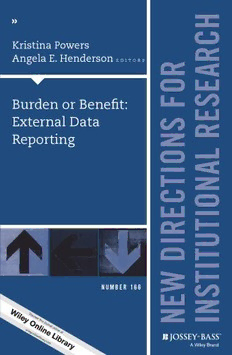Table Of Contenth
»
c
Kristina Powers
r
Angela E. Henderson
Editors r
a
oe
fs
Burden or Benefit:
e
External data s
r
N
reporting
ol
a
i
tN
c
o
e
i
rt
u
i
D
t
i
wt
Number 166 s
e
N
N
i
NewDirectionsfor
InstitutionalResearch
JohnF.Ryan
Editor-in-Chief
GloriaCrisp
AssociateEditor
Burden or Benefit:
External Data
Reporting
Kristina Powers
Angela E. Henderson
Editors
Number166
Jossey-Bass
SanFrancisco
BURDENORBENEFIT:EXTERNALDATAREPORTING
KristinaPowers,AngelaE.Henderson(eds.)
NewDirectionsforInstitutionalResearch,no.166
JohnF.Ryan,Editor-in-Chief
GloriaCrisp,AssociateEditor
Copyright©2016WileyPeriodicals,Inc.,AWileyCompany
Allrightsreserved.Nopartofthispublicationmaybereproducedinany
formorbyanymeans,exceptaspermittedundersection107or108ofthe
1976UnitedStatesCopyrightAct,withouteitherthepriorwrittenper-
missionofthepublisherorauthorizationthroughtheCopyrightClear-
anceCenter,222RosewoodDrive,Danvers,MA01923;(978)750-8400;
fax(978)646-8600.Thecodeandcopyrightnoticeappearingatthebot-
tomofthefirstpageofanarticleinthisjournalindicatethecopyright
holder’sconsentthatcopiesmaybemadeforpersonalorinternaluse,
orforpersonalorinternaluseofspecificclients,ontheconditionthat
thecopierpayforcopyingbeyondthatpermittedbylaw.Thisconsent
doesnotextendtootherkindsofcopying,suchascopyingforgeneral
distribution,foradvertisingorpromotionalpurposes,forcreatingcollec-
tiveworks,orforresale.Suchpermissionrequestsandotherpermission
inquiriesshouldbeaddressedtothePermissionsDepartment,c/oJohn
Wiley&Sons,Inc.,111RiverSt.,Hoboken,NJ07030;(201)748-8789,
fax(201)748-6326,http://www.wiley.com/go/permissions.
NEWDIRECTIONSFORINSTITUTIONALRESEARCH(ISSN0271-0579,electronic
ISSN1536-075X)ispartofTheJossey-BassHigherandAdultEducation
Series and is published quarterly by Wiley Subscription Services, Inc.,
AWileyCompany,atJossey-Bass,OneMontgomeryStreet,Suite1200,
SanFrancisco,California94104-4594(publicationnumberUSPS098-
830).POSTMASTER:SendaddresschangestoNewDirectionsforInsti-
tutionalResearch,Jossey-Bass,OneMontgomeryStreet,Suite1200,San
Francisco,California94104-4594.
INDIVIDUAL SUBSCRIPTION RATE (in USD): $89 per year US/Can/Mex,
$113 rest of world; institutional subscription rate: $341 US, $381
Can/Mex, $415 rest of world. Single copy rate: $29. Electronic only–
all regions: $89 individual, $341 institutional; Print & Electronic–US:
$98individual,$410institutional;Print&Electronic–Canada/Mexico:
$98 individual, $450 institutional; Print & Electronic–Rest of World:
$122individual,$484institutional.
EDITORIAL CORRESPONDENCE should be sent to John F. Ryan at
[email protected].
NewDirectionsforInstitutionalResearchisindexedinAcademicSearch
(EBSCO), Academic Search Elite (EBSCO), Academic Search Premier
(EBSCO),CIJE:CurrentIndextoJournalsinEducation(ERIC),Contents
Pages in Education (T&F), EBSCO Professional Development Collection
(EBSCO),EducationalResearchAbstractsOnline(T&F),ERICDatabase
(Education Resources Information Center), Higher Education Abstracts
(Claremont Graduate University), Multicultural Education Abstracts
(T&F),SociologyofEducationAbstracts(T&F).
Coverdesign:Wiley
CoverImages:©Lava4images|Shutterstock
Microfilmcopiesofissuesandchaptersareavailablein16mmand35mm,
aswellasmicrofichein105mm,throughUniversityMicrofilms,Inc.,300
NorthZeebRoad,AnnArbor,Michigan48106-1346.
www.josseybass.com
THE ASSOCIATION FOR INSTITUTIONAL RESEARCH (AIR) is the world’s largest
professionalassociationforinstitutionalresearchers.Theorganizationpro-
vides educational resources, best practices, and professional development
opportunitiesformorethan4,000members.Itsprimarypurposeistosup-
port members in the process of collecting, analyzing, and converting data
intoinformationthatsupportsdecisionmakinginhighereducation.
C
ONTENTS
EDITORS’NOTES 7
KristinaPowers,AngelaE.Henderson
1. TransparencyforWhom?ImpactsofAccountability 11
MovementsforInstitutionalResearchersandBeyond
P.DanielChen,R.MichaelHaynes
This chapter explores external reporting as a tool to increase institu-
tional transparency and suggests guiding questions for institutional
consideration.
2. GrowthofBurdeninFederalandStateReporting 23
AngelaE.Henderson
This chapter discusses the expanding demands of prominent federal
and state reporting requirements and the resulting impact on institu-
tionalresearch.
3. BurdenintheEyeoftheBeholder:WhyShould 35
AdministrationCare?
YanliMa,JamesKulich,ShoupingHu
An examination of differing perspectives on the value of external
reporting illustrates how perception influences the quality of data
reporting.
4. MaximizingInstitutionalResearchImpactThroughBuilding 47
RelationshipsandCollaboratingWithintheInstitution
YvonneKocheraKirby,NancyD.Floyd
Thischapterexaminesthenecessityofdevelopingpartnershipswithin
andoutsideoftheinstitutiontoensureconsistent,correct,andtimely
dataforoptimalinstitutionaldecisionmaking.
5. EasingtheBurdenofExternalReporting 61
MarcF.LoGrasso
This chapter provides suggestions for improving the effectiveness of
externalreportingwhileminimizingburden.
6. Benchmarking—CurrentAvailability,PossibleNewNational 73
Alternatives,andMakingaContributiontotheDiscussion
EricS.Atchison,BradenJ.Hosch
This chapter discusses the benefits, limitations, and burdens of Inte-
gratedPostsecondaryEducationDataSystemdatacollection,alterna-
tiveapproaches,andpossibleimplicationsoftheseapproaches.
7. GuidebooksandRankings:TheValueofOptionalExternal 89
Reporting
JuliaCarpenter-Hubin,LianaCrisan-Vandeborne
Adiscussionofthebenefitsandcostsofparticipationinoptionalex-
ternal reporting is accompanied by considerations for determining if
benefitsjustifydedicationofresources.
8. FutureofExternalReporting 101
KristinaPowers
Thischapterexaminestheimpactofexternalreportinggrowthoninsti-
tutionalresearchersandprovidesconsiderationsfordealingwithfuture
reportingdemands.
INDEX 111
E ’ N
DITORS OTES
Twenty-five years ago, Wilton (1990) noted that reporting of student data
absorbedthebulkofaninstitutionalresearcher’sresources.Externalreport-
ing demands have expanded significantly in the years since. This growth
canbeattributedtoacombinationofeconomic,political,andgovernmen-
talfactorsgivingrisetoincreasedscrutinyofhighereducationpracticesand
outcomes(Zumeta,2000).Thistopichasnotbeenexploredindepthwith
regard to the impact on higher education in general; an understanding of
thescopeofreportingrequirementsandtheassociatedburdeniscriticalto
highereducationpractitioners.
Thereislittletonodebatefrominstitutionalresearchersthatthescope
of reporting to external agencies has increased in volume, quantity, and
complexity. However, there is some contention as to whether external re-
portingrepresentsanopportunityforbenefitoraninstitutionalburden.If
reportingisbeneficial,considerationshouldbegiventowhohasthemostto
gainfrominstitutionalparticipation.Students,faculty,staff,thepublic,and
the institution itself all stand to benefit from appropriate external report-
ing.However,withincreasingworkloads,institutionalresearchersoftendo
not have time to review every request critically to determine the potential
valueofparticipation.Respondingtorequestswithoutcontextualconsider-
ationcreatesacultureofdatasolelyforthesakeofexternaldatademands,
often without examination of what the data mean to the institution. As
Sanford(1995)noted,“responsibleuseofdatamustaccompanyincreased
access, or the result will be not better information but more confusion”
(p.86).
Volkwein (2008) observed responding to reporting requirements as-
sociated with the rise of accountability and transparency was becoming a
more important role for many institutional researchers. The days of insti-
tutional research evaluating, completing, and submitting external reports
in isolation have disappeared. Increased collaboration and administrative
oversighthavebecomestandardasadministratorsrealizetheimpactexter-
nal reporting can have upon an institution’s perceived accountability and
transparency. Now more than ever, administrators are keenly aware that
reportinghasthepotentialtoinfluencefactorssuchasadmissions,reputa-
tion,andfederalaudits.Suchhigh-levelattentiontoexternalreportingcan
be beneficial to the institution, as it validates the expenditure of institu-
tionalresourcesrequiredtoensureaccuratereportingandfostersaculture
ofdatarelevance.Further,itincreasestheawarenessofexternaldataandal-
lowsinstitutionstoensureexternalagenciesarerepresentinginstitutionally
submitteddatainanappropriateandaccurateway(Davis,1981).
NPuEbWliDshIReEdCoTnIOliNnSeFiOnRWINiSleTyITOUTnIOliNnAeLLRibErSaErAyRC(wH,ilneoyo.n16li6ne©lib2r0ar1y6.cWomil)ey•PeDrOioId:i1c0al.s1,0I0n2c/.ir.20126 7
8 BURDENORBENEFIT:EXTERNALDATAREPORTING
Tobroadenthediscussionofthistopicarea,thisvolumefeatureseight
chapters, each focused on a specific aspect of institutional reporting and
theassociatedburden.Dividedintotwosections,thisvolumecontainsin-
formationforbothnewandexperiencedinstitutionalresearchersandthose
whoworkcloselywithinstitutionalresearchfunctions.Chapters1–3pro-
videimportantdetailedbackgroundandcontextonexternalreporting.
InChapter1,ChenandHaynesintroduceanddiscussthefoundation
ofexternalreporting—transparency.Theyexaminekeyexternalstakehold-
ersandrecognizehoweachgrouphasshapedexternalreportingforinstitu-
tionalresearchers.Hendersoncontinuesthediscussiononexternalreport-
ingwithadetaileddiscussionoftheextraordinarygrowththatinstitutional
researchershavefeltinbothfederalandstatereporting.Althoughthischap-
ter occurs in the first section to provide background information, experi-
encedinstitutionalresearchersmayfindChapter2providessolidevidence
to validate what they have known for some time—the amount of exter-
nal reporting has increased substantially. As the final background chapter,
Ma,KulichandHuexaminetheimpactofexternalreportingonaudiences
within the institution in Chapter 3. They highlight the importance of in-
stitutionalresearchersunderstandinginternalstakeholders’motivationsin
ordertogarnertheirsupportandinterestinexternalreporting.
Chapters4–8focusonkeyissuesandstrategiesforaddressingexternal
reportingattheinstitutionallevel,includingthosethatareeithercurrently
changing or appear to be on the brink of change, and therefore, should
be monitored. In their chapter on building and maintaining relationships,
Kirby and Floyd (Chapter 4) discuss how an increase in external report-
inghasledtotheneedforstrongerrelationshipswithintheinstitution.In
Chapter 5 LoGrasso considers technical and operational aspects of insti-
tutional researchers completing complex and numerous external reports.
Atchison and Hosch bring readers a comprehensive chapter on Integrated
PostsecondaryEducationDataSystemdatasetsfortransparencyandexter-
nalreportingbeforepresentingcurrentalternateoptionsfornationalbench-
markinginChapter6.
Thus far, chapter authors have focused primarily on mandatory
external reporting. However, in Chapter 7 Carpenter-Hubin and Crisan-
Vandeborneaddresskeyconsiderationsregardingoptionalexternalreport-
ing. The authors provide factors to help determine the value of participa-
tion in optional external reporting to which institutional researchers can
refer when presenting justifications to leadership. The volume concludes
with Powers’ (Chapter 8) discussion on the future of external reporting.
The chapter underscores the changing higher education landscape of ex-
ternal reporting and makes the point that current issues facing one sector
todaymayimpactothersectorsintheimmediatefuture.Thus,readersare
encouragedtoconsiderreadingtheentireissuewithinthebroadframework
ofhowexternalreportingimpactshighereducation,notjustasinglesector
orinstitutionaltype.
NEWDIRECTIONSFORINSTITUTIONALRESEARCH•DOI:10.1002/ir

